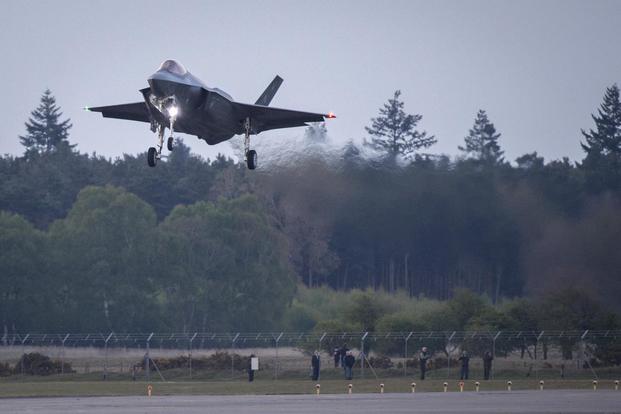A technology that can help prevent pilots from colliding with the ground has begun its initial testing on the F-35 Joint Strike Fighter.
The Air Force variant of the fifth-generation jet has begun flying with the Automatic Ground Collision Avoidance System, known as Auto-GCAS, in recent tests at Edwards Air Force Base, California, the Air Force said in a news release. The 461st Flight Test Squadron recently began test flights to see if Auto-GCAS remained compatible with the other computer systems on board the Lockheed Martin-made aircraft.
"Auto-GCAS saves lives, it's been proven in the F-16 and the F-22," Lt. Col. Tucker Hamilton, F-35 Integrated Test Force director and 461st commander, said in the release. "We've been able to be an advocate to the warfighter, and the F-35 enterprise as a whole, to get them to accelerate implementation of F-35 Auto-GCAS by about seven years."
Related content:
- Aviation Accident Spike Has Services Scrambling for Solutions
- New Software Will Prevent F-35 Pilots from Flying into the Ground
- Lawmakers Rip Brass for Handling of Hypoxia Incidents
Auto-GCAS was developed in the 1990s, but early versions had data issues. It was re-engineered between 2003 and 2010, and by 2016, it had been installed on more than 600 F-16 Fighting Falcon aircraft, "resulting in three confirmed reports that Auto-GCAS saved both the pilot and aircraft," according to the Air Force.
The service at the time said Auto-GCAS would not only save lives, but also "upward of 14 aircraft, and more than $530 million over the projected remaining service life of the F-16 inventory alone."
To date, the system has been credited with saving the lives of seven pilots in six different aircraft.
Auto-GCAS uses various sensors that monitor how the aircraft is performing and whether the pilot is still in control of the aircraft. If a pilot loses consciousness, Auto GCAS kicks in. The sensors that feed into the system take into consideration the terrain below, the aircraft's trajectory and speed and the human inputs, or lack thereof, to calculate how to best recover the jet and bring it back down safely, or return it to a smooth trajectory, the release said.
"This technology is the stepping stone to increased combat capability via a fully capable combat autopilot that will be able to execute tactical maneuvers to defeat inbound kinetic and non-kinetic threats and maximize lethality through precise weapon employment," added Lt. Col. Raven LeClair, a test pilot with the 461st, in a statement.
In January, Vice Adm. Mat Winter, head of the F-35 Joint Program Office, said the Auto-GCAS system was coming roughly five years earlier than originally planned.
"Expediting this lifesaving technology into the F-35 fleet by 2019 is estimated to prevent the loss of three aircraft, and more importantly, save the lives of three pilots," Winter said in a news release. "Over the service life of the F-35 fleet, having Auto-GCAS is estimated to prevent more than 26 ground collisions from happening."
Pilots themselves have helped speed that process along, according to Lockheed officials.
"The implementation of it is going faster than we thought [it would]," said Greg Ulmer, vice president for the Lockheed Martin F-35 aircraft production business.
Ulmer said the expedited timeline is due to the fact that Lockheed began an "agile construct" where an operator -- such as a pilot -- is "embedded as part of the development team."
"So we've seen some strong performance in that regard in Auto-GCAS in particular," Ulmer told Military.com in September.
But it's not a foolproof solution for an in-flight emergency, Hamilton said.
"The pilot cannot use Auto-GCAS as a crutch," he said. "It's very important they do everything in their power to execute the mission without relying on any safety net to protect them. They've got to execute not thinking it's there, they should execute with that mindset. And then if it saves them, it saves them."
Hamilton stressed that it's better to be over-prepared in any case.
"It is our responsibility to use the technology to be able to bring [pilots] home every day, that's something they deserve and it's something we have the capability to provide," Hamilton said.
-- Oriana Pawlyk can be reached at oriana.pawlyk@military.com. Follow her on Twitter at @oriana0214.









